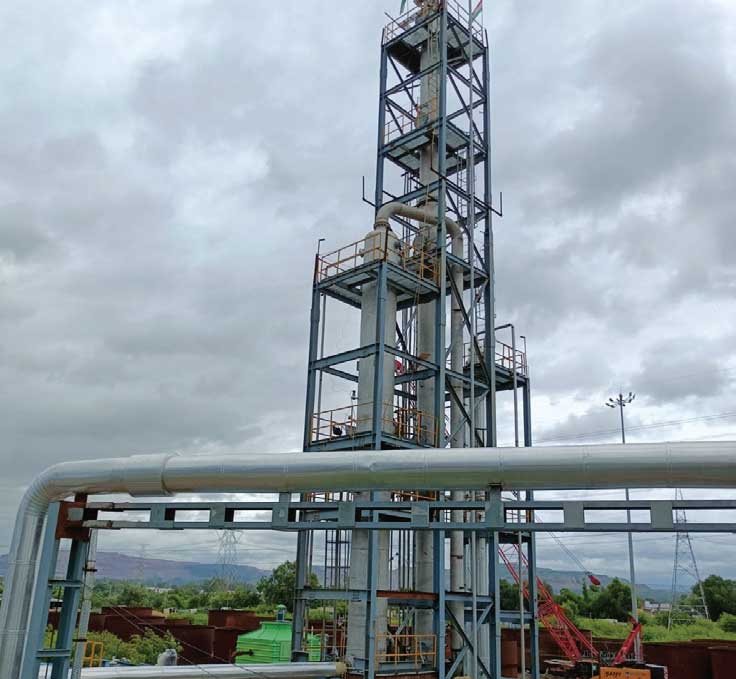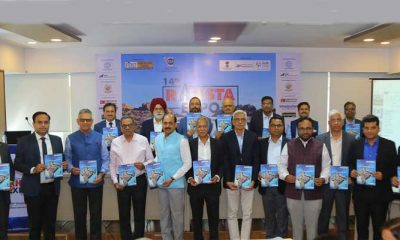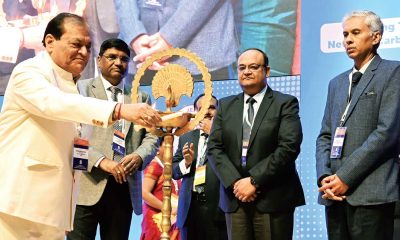Product development
Many industrial sectors are sending their waste to cement plants
Published
3 years agoon
By
admin
Bharathi Cement of Vicat Group uses Alternate Raw Materials and Fuels (AFR) extensively in its kilns. Milind Murumkar, Advisor, Vicat Group, speaks on the latest trends in this field.
How have things changed over the last 10 years in the field of Alternate Raw Materials and Fuels?
There have been remarkable changes in the last 10 years in the field of AFR in India. Thermal substitution has shown a very positive trend year-on-year, though at a very slow pace earlier, and picking up later in the last two-three years to a level of around 4 per cent.
The basic reasons for this can be broadly assigned to lack of knowledge on AFR usage in the Indian cement industry in early years, especially on usage of industrial waste, lack of skilled persons for handling & usage of industrial wastes, lack of proper infrastructure for storage & feeding of AFR materials to cement kilns, lack of proper understanding on the permitting process in regulatory bodies and above all, the will to receive and use waste materials in cement plants.
In the last two years, a remarkable transformation has been noticed in all the above aspects with dramatic changes in the mindset of regulatory bodies, plant operating professionals and also in the waste generators who are shifting to co-processing as a better option over land-filling and incineration as it provides a cost-effective option to them. In April 2016, with the revised Environment Ministry rules that incorporate co-processing as the better option for recovery of energy, the scenario is changing fast towards higher utilisation of different types of wastes in cement kilns.
Cement plants have also made proper investments to improve their infrastructure that can help in scientific disposal of industrial waste in the plants in a sustainable manner, for proper handling, storage and feeding of different types of wastes at appropriate points in the kiln system, without affecting the product quality and the environment.
In short, cement plants are focussing on higher usage of all types of waste and are reducing their dependency on conventional fuels and raw materials.
Tell us something on fingerprinting of AFR materials, and how and why it is done. After fingerprinting, how do you take care of variations in the incoming materials?
At a cement plant, we create systems for preparation of a homogenised raw mix that is fed to a kiln. Cement plants also need to know the characteristics of the waste that is to be co-processed and its compatibility with the raw material being used, to avoid process fluctuations and kiln operating instabilities.
Normally during the preliminary visit to the waste generators, one should try to understand the waste characteristics, the waste material safety data (MSD), etc. Proper samples are collected for analysis and reviewed if the waste can be co-processed or not. During the proposal and agreement finalisation with the waste generators, this aspect is considered for defining the quantities and the safety aspects of the waste.
Fingerprinting analysis is done to ensure that the waste is in line with the agreement and safe to be handled, stored and used in the required proportion that will not affect the product quality and the environment.
In the plants that are utilising higher quantities of wastes, it is desirable to have a proper waste fingerprinting analysis laboratory. Moreover in plants that are utilising different types of waste, it is also desirable to have a proper pre-processing facility for feeding a uniform quality of processed waste to the kiln system. Based on the quality of this processed waste, suitable changes in the raw material composition can be done to ensure that required balances in the material characteristics are effected before the material gets fed to the kiln system, for steady operation of kiln and uniform quality of desired product. A few third parties are also looking into creation of such pre-processing facilities for supply of processed waste to cement plants.
Give us more details on co-processing. Can alternate fuel alone be used as fuel?
Co-processing is a proven sustainable development concept that reduces dependency on natural resources and reduces pollution & landfill space, thus contributing to reducing the environmental footprint.
Co-processing is also based on the principles of industrial ecology, which consider the best features of the flow of information, materials, and energy of biological ecosystems, with the aim of improving the exchange of these essential resources in the industrial world.
AFR can also be used alone as fuel in cement kilns. A proper understanding of the processes, raw material characteristics and the waste compositions are the key factors that need to be assessed before use of AFR in a particular kiln system.
Benefits of Co-processing
Co-processing conserves natural (non-renewable) resources of energy and materials, reduces emissions of greenhouse gases, slowing global warming, and demonstrates a positive impact on integrated environmental indicators, such as the ecological footprint. Co-processing reduces the environmental impacts of the extraction (mining or quarrying), transporting, and processing of raw materials. It reduces dependence on primary resource markets. Co-processing saves landfill space and reduces the pollution caused by the disposal of waste. Moreover, co-processing destroys waste completely, eliminating potential future liabilities.
Provide us more information on the use of industrial waste as fuel. What have been the success factors and the failures? What has been the response from the industry?
As indicated earlier, with improvements in the permitting processes by regulatory authorities and the creation of proper infrastructure by cement plants, waste generators are also getting aligned for sending their waste to cement plants, as it is a much more cost-effective option for them. Many industrial sectors like pharmaceuticals, FMCG, automobiles, chemicals, metallurgical, plastics, etc., are sending their waste to cement plants.
A proper scientific waste assessment is needed that can provide a complete survey of the waste generated by an industry with a complete assessment of its suitability for co-processing.
There?s a need to have a dedicated laboratory for waste fingerprint analysis to analyse the waste in cement plants, to ensure that it is suitable for co-processing. The plant should be geared enough to manage waste such as solids, semi-solids, sludge and liquids, as waste generators normally prefer plants that can offer a complete solution to all their types of waste.
Waste transportation needs have to be well understood, ensuring that the waste is transported in appropriate packaging with required labelling and documentation. The waste is carried by operators with required skills, qualifications and permits. Pre-processing of different wastes is preferred to blend liquids, shred solid materials and homogenise waste, prior to usage in kilns.
There are facilities for co-processing of the pre-processed waste in cement kilns. Since cement kilns operate at temperatures of up to 2,000?C, there is no residue or waste after co-processing.
Give us some idea on the use of Municipal Solid Waste (MSW) as a fuel. What are the bottlenecks? Which municipal corporations have made some planning in this direction?
Large quantities of MSW are available in India in every state and in every city. They can be used in cement plants if proper segregated MSW as RDF (Refuse Derived Fuel) is made available to them. The basic difficulty is the quality of RDF that is being generated at the RDF plants. The RDF produced from MSW in these plants is highly heterogeneous with moisture to the tune of 30-40 per cent, which creates problems of conveying and usage in cement plants. The problems of these RDF plants are in the input MSW material received by them and they have no control on these receipts. Some cement plants have created facilities for usage of RDF by investing in pneumatic or mechanical conveying systems and yet the usage is very low due to high moisture and the heterogeneity of material. The RDF producing plants are trying to develop systems for improving the quality to some extent, but largely no concrete steps are being taken by municipalities for improving the quality of RDF going to cement plants.
However, some concrete steps are being taken for installation of waste-to-energy plants for utilising segregated MSW for power generation. It is too early to comment on the success of these plants. We need further time to assess their performance and outcome. Even the authorities at the Central and state level are largely concerned with the menace of increasing MSW generation and proper disposal of this material, as large-scale environmental issues are cropping up at every MSW storage location.
Tell us about the success story at Bharathi Cement; what has been your TSR and at what location? What kind of alternate fuels do you use? What is the road ahead?
The success story of the Vicat Group is quite enviable compared to our peers. We started using AFR at our Kadapa plant in the year 2011 and there has been a four-fold increase in the TSR over the last four-five years. Today the substitution rate at our Vicat plants is 20 per cent. Huge investments have been made in creating world-class infrastructure at our plants for utilising different kinds of wastes which are hazardous and non-hazardous. Proper feeding systems have been provided as per the material characteristics and their forms like for liquids, semisolids & solids, RDF and plastic wastes etc.
The different kinds of waste we use in the plants are pharmaceutical waste, food & beverages/FMCG, black carbon and dolachar firewood, biomass (mango seeds), RDF from municipal solid waste, used tyres, etc. We have set up a well-equipped laboratory for proximate, ultimate and heavy metal analysis of waste. A team of 50 personnel is working for alternate fuels to increase the substitution rate. All our stacks and ambient air quality monitoring stations are well connected with the APPCB website. We have also arranged fire-fighting equipment, fire hydrant systems, etc. It is our commitment to reach a substitution rate of up to 40 per cent by end of 2020.
Milind Murumkar working as an Advisor AFR, Vicat Group, provides waste management solution. He had a long association with ACC Ltd in various disciplines. He has been successful in bringing regulatory changes in the waste management.
You may like

Advertising or branding is never about driving sales. It’s about creating brand awareness and recall. It’s about conveying the core values of your brand to your consumers. In this context, why is branding important for cement companies? As far as the customers are concerned cement is simply cement. It is precisely for this reason that branding, marketing and advertising of cement becomes crucial. Since the customer is unable to differentiate between the shades of grey, the onus of creating this awareness is carried by the brands. That explains the heavy marketing budgets, celebrity-centric commercials, emotion-invoking taglines and campaigns enunciating the many benefits of their offerings.
Marketing strategies of cement companies have undergone gradual transformation owing to the change in consumer behaviour. While TV commercials are high on humour and emotions to establish a fast connect with the customer, social media campaigns are focussed more on capturing the consumer’s attention in an over-crowded virtual world. Branding for cement companies has become a holistic growth strategy with quantifiable results. This has made brands opt for a mix package of traditional and new-age tools, such as social media. However, the hero of every marketing communication is the message, which encapsulates the unique selling points of the product. That after all is crux of the matter here.
While cement companies are effectively using marketing tools to reach out to the consumers, they need to strengthen the four Cs of the branding process – Consumer, Cost, Communication and Convenience. Putting up the right message, at the right time and at the right place for the right kind of customer demographic is of utmost importance in the long run. It is precisely for this reason that regional players are likely to have an upper hand as they rely on local language and cultural references to drive home the point. But modern marketing and branding domain is exponentially growing and it would be an interesting exercise to tabulate and analyse its impact on branding for cement.
Concrete
Indian cement industry is well known for its energy and natural resource efficiency
Published
1 year agoon
November 18, 2022By
admin
Dr Hitesh Sukhwal, Deputy General Manager – Environment, Udaipur Cement Works Limited (UCWL) takes us through the multifaceted efforts that the company has undertaken to keep emissions in check with the use of alternative sources of energy and carbon capture technology.
Tell us about the policies of your organisation for the betterment of the environment.
Caring for people is one of the core values of our JK Lakshmi Cement Limited. We strongly believe that we all together can make a difference. In all our units, we have taken measures to reduce carbon footprint, emissions and minimise the use of natural resources. Climate change and sustainable development are major global concerns. As a responsible corporate, we are committed with and doing consistent effort small or big to preserve and enrich the environment in and around our area of operations.
As far as environmental policies are concerned, we are committed to comply with all applicable laws, standards and regulations of regulatory bodies pertaining to the environment. We are consistently making efforts to integrate the environmental concerns into the mainstream of the operations. We are giving thrust upon natural resource conservation like limestone, gypsum, water and energy. We are utilising different kinds of alternative fuels and raw materials. Awareness among the employees and local people on environmental concerns is an integral part of our company. We are adopting best environmental practices aligned with sustainable development goals.
Udaipur Cement Works Limited is a subsidiary of the JK Lakshmi Cement Limited. Since its inception, the company is committed towards boosting sustainability through adopting the latest art of technology designs, resource efficient equipment and various in-house innovations. We are giving thrust upon renewable and clean energy sources for our cement manufacturing. Solar Power and Waste Heat Recovery based power are our key ingredients for total power mix.
What impact does cement production have on the environment? Elaborate the major areas affected.
The major environmental concern areas during cement production are air emissions through point and nonpoint sources due to plant operation and emissions from mining operation, from material transport, carbon emissions through process, transit, noise pollution, vibration during mining, natural resource depletion, loss of biodiversity and change in landscape.
India is the second largest cement producer in the world. The Indian cement industry is well known for its energy and natural resource efficiency worldwide. The Indian cement industry is a frontrunner for implementing significant technology measures to ensure a greener future.
The cement industry is an energy intensive and significant contributor to climate change. Cement production contributes greenhouse gases directly and indirectly into the atmosphere through calcination and use of fossil fuels in an energy form. The industry believes in a circular economy by utilising alternative fuels for making cement. Cement companies are focusing on major areas of energy efficiency by adoption of technology measures, clinker substitution by alternative raw material for cement making, alternative fuels and green and clean energy resources. These all efforts are being done towards environment protection and sustainable future.
Nowadays, almost all cement units have a dry manufacturing process for cement production, only a few exceptions where wet manufacturing processes are in operation. In the dry manufacturing process, water is used only for the purpose of machinery cooling, which is recirculated in a closed loop, thus, no polluted water is generated during the dry manufacturing process.
We should also accept the fact that modern life is impossible without cement. However, through state-of-the-art technology and innovations, it is possible to mitigate all kinds of pollution without harm to the environment and human beings.
Tell us about the impact blended cement creates on the environment and emission rate.
Our country started cement production in 1914. However, it was introduced in the year 1904 at a small scale, earlier. Initially, the manufacturing of cement was only for Ordinary Portland Cement (OPC). In the 1980s, the production of blended cement was introduced by replacing fly ash and blast furnace slag. The production of blended cement increased in the growth period and crossed the 50 per cent in the year 2004.
The manufacturing of blended cement results in substantial savings in the thermal and electrical energy consumption as well as saving of natural resources. The overall consumption of raw materials, fossil fuel such as coal, efficient burning and state-of-the-art technology in cement plants have resulted in the gradual reduction of emission of carbon dioxide (CO2). Later, the production of blended cement was increased in manifolds.
If we think about the growth of blended cement in the past few decades, we can understand how much quantity of , (fly ash and slag) consumed and saved natural resources like limestone and fossil fuel, which were anyhow disposed of and harmed the environment. This is the reason it is called green cement. Reduction in the clinker to cement ratio has the second highest emission reduction potential i.e., 37 per cent. The low carbon roadmap for cement industries can be achieved from blended cement. Portland Pozzolana Cement (PPC), Portland Slag Cement (PSC) and Composite Cement are already approved by the National Agency BIS.
As far as kilogram CO2 per ton of cement emission concerns, Portland Slag Cement (PSC) has a larger potential, other than PPC, Composite Cement etc. for carbon emission reduction. BIS approved 60 per cent slag and 35 per cent clinker in composition of PSC. Thus, clinker per centage is quite less in PSC composition compared to other blended cement. The manufacturing of blended cement directly reduces thermal and process emissions, which contribute high in overall emissions from the cement industry, and this cannot be addressed through adoption of energy efficiency measures.
In the coming times, the cement industry must relook for other blended cement options to achieve a low carbon emissions road map. In near future, availability of fly ash and slag in terms of quality and quantity will be reduced due to various government schemes for low carbon initiatives viz. enhance renewable energy sources, waste to energy plants etc.
Further, it is required to increase awareness among consumers, like individual home builders or large infrastructure projects, to adopt greener alternatives viz. PPC and PSC for more sustainable
resource utilisation.
What are the decarbonising efforts taken by your organisation?
India is the world’s second largest cement producer. Rapid growth of big infrastructure, low-cost housing (Pradhan Mantri Awas Yojna), smart cities project and urbanisation will create cement demand in future. Being an energy intensive industry, we are also focusing upon alternative and renewable energy sources for long-term sustainable business growth for cement production.
Presently, our focus is to improve efficiency of zero carbon electricity generation technology such as waste heat recovery power through process optimisation and by adopting technological innovations in WHR power systems. We are also increasing our capacity for WHR based power and solar power in the near future. Right now, we are sourcing about 50 per cent of our power requirement from clean and renewable energy sources i.e., zero carbon electricity generation technology. Usage of alternative fuel during co-processing in the cement manufacturing process is a viable and sustainable option. In our unit, we are utilising alternative raw material and fuel for reducing carbon emissions. We are also looking forward to green logistics for our product transport in nearby areas.
By reducing clinker – cement ratio, increasing production of PPC and PSC cement, utilisation of alternative raw materials like synthetic gypsum/chemical gypsum, Jarosite generated from other process industries, we can reduce carbon emissions from cement manufacturing process. Further, we are looking forward to generating onsite fossil free electricity generation facilities by increasing the capacity of WHR based power and ground mounted solar energy plants.
We can say energy is the prime requirement of the cement industry and renewable energy is one of the major sources, which provides an opportunity to make a clean, safe and infinite source of power which is affordable for the cement industry.
What are the current programmes run by your organisation for re-building the environment and reducing pollution?
We are working in different ways for environmental aspects. As I said, we strongly believe that we all together can make a difference. We focus on every environmental aspect directly / indirectly related to our operation and surroundings.
If we talk about air pollution in operation, every section of the operational unit is well equipped with state-of-the-art technology-based air pollution control equipment (BagHouse and ESP) to mitigate the dust pollution beyond the compliance standard. We use high class standard PTFE glass fibre filter bags in our bag houses. UCWL has installed the DeNOx system (SNCR) for abatement of NOx pollution within norms. The company has installed a 6 MW capacity Waste Heat Recovery based power plant that utilises waste heat of kiln i.e., green and clean energy source. Also, installed a 14.6 MW capacity solar power system in the form of a renewable energy source.
All material transfer points are equipped with a dust extraction system. Material is stored under a covered shed to avoid secondary fugitive dust emission sources. Finished product is stored in silos. Water spraying system are mounted with material handling point. Road vacuum sweeping machine deployed for housekeeping of paved area.
In mining, have deployed wet drill machine for drilling bore holes. Controlled blasting is carried out with optimum charge using Air Decking Technique with wooden spacers and non-electric detonator (NONEL) for control of noise, fly rock, vibration, and dust emission. No secondary blasting is being done. The boulders are broken by hydraulic rock breaker. Moreover, instead of road transport, we installed Overland Belt Conveying system for crushed limestone transport from mine lease area to cement plant. Thus omit an insignificant amount of greenhouse gas emissions due to material transport, which is otherwise emitted from combustion of fossil fuel in the transport system. All point emission sources (stacks) are well equipped with online continuous emission monitoring system (OCEMS) for measuring parameters like PM, SO2 and NOx for 24×7. OCEMS data are interfaced with SPCB and CPCB servers.
The company has done considerable work upon water conservation and certified at 2.76 times water positive. We installed a digital water flow metre for each abstraction point and digital ground water level recorder for measuring ground water level 24×7. All digital metres and level recorders are monitored by an in-house designed IoT based dashboard. Through this live dashboard, we can assess the impact of rainwater harvesting (RWH) and ground water monitoring.
All points of domestic sewage are well connected with Sewage Treatment Plant (STP) and treated water is being utilised in industrial cooling purposes, green belt development and in dust suppression. Effluent Treatment Plant (ETP) installed for mine’s workshop. Treated water is reused in washing activity. The unit maintains Zero Liquid Discharge (ZLD).
Our unit has done extensive plantations of native and pollution tolerant species in industrial premises and mine lease areas. Moreover, we are not confined to our industrial boundary for plantation. We organised seedling distribution camps in our surrounding areas. We involve our stakeholders, too, for our plantation drive. UCWL has also extended its services under Corporate Social Responsibility for betterment of the environment in its surrounding. We conduct awareness programs for employees and stakeholders. We have banned Single Use Plastic (SUP) in our premises. In our industrial township, we have implemented a solid waste management system for our all households, guest house and bachelor hostel. A complete process of segregated waste (dry and wet) door to door collection systems is well established.
Tell us about the efforts taken by your organisation to better the environment in and around the manufacturing unit.
UCWL has invested capital in various environmental management and protection projects like installed DeNOx (SNCR) system, strengthening green belt development in and out of industrial premises, installed high class pollution control equipment, ground-mounted solar power plant etc.
The company has taken up various energy conservation projects like, installed VFD to reduce power consumption, improve efficiency of WHR power generation by installing additional economiser tubes and AI-based process optimisation systems. Further, we are going to increase WHR power generation capacity under our upcoming expansion project. UCWL promotes rainwater harvesting for augmentation of the ground water resource. Various scientifically based WHR structures are installed in plant premises and mine lease areas. About 80 per cent of present water requirement is being fulfilled by harvested rainwater sourced from Mine’s Pit. We are also looking forward towards green transport (CNG/LNG based), which will drastically reduce carbon footprint.
We are proud to say that JK Lakshmi Cement Limited has a strong leadership and vision for developing an eco-conscious and sustainable role model of our cement business. The company was a pioneer among cement industries of India, which had installed the DeNOx (SNCR) system in its cement plant.
Concrete
NTPC selects Carbon Clean and Green Power for carbon capture facility
Published
2 years agoon
October 12, 2022By
admin
Carbon Clean and Green Power International Pvt. Ltd has been chosen by NTPC Energy Technology Research Alliance (NETRA) to establish the carbon capture facility at NTPC Vindhyachal. This facility, which will use a modified tertiary amine to absorb CO2 from the power plant’s flue gas, is intended to capture 20 tonnes of CO2) per day. A catalytic hydrogenation method will eventually be used to mix the CO2 with hydrogen to create 10 tonnes of methanol each day. For NTPC, capturing CO2 from coal-fired power plant flue gas and turning it into methanol is a key area that has the potential to open up new business prospects and revenue streams.

RAHSTA to showcase cutting-edge road construction tech, says NCC Director

RAHSTA will drive road construction innovation: Sundaresan

New appointment at TMEIC

Social Impact Award for Ambuja Cements

UCWL unveils new plant in Dabok, Udaipur

Environment Ministry revises rules of solid waste management

M-sand boards new terrain

Process and quality optimization in cement plant.
Concrete: A Highly Sustainable Building Material

Adani Group eyes Jaiprakash Associates’ Shahabad cement plant
Trending News
-

 Concrete1 week ago
Concrete1 week agoFiltration can help to control climate change
-

 Economy & Market3 weeks ago
Economy & Market3 weeks agoRoad construction industry to launch RAHSTA Expo 2024
-

 Economy & Market2 weeks ago
Economy & Market2 weeks agoRoad construction leaders launch RAHSTA Expo 2024 in Delhi
-

 Economy & Market1 week ago
Economy & Market1 week agoDigitalisation is changing the logistics landscape









